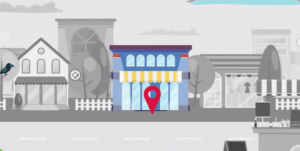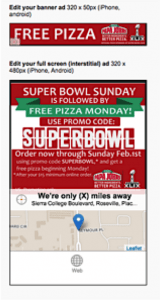Targeting the right audience for a marketing message at the right time has always been a challenge for professionals in the industry. Thanks to the smartphone, however, there’s now a new strategy in play for big and small companies alike-geofencing marketing.
The key benefit of geofencing is its ability to target potential customers precisely with relevant ads or notifications when they are most likely to buy something—that is, when they’re in close proximity to your store or business. This helps brands build relationships with potential customers by providing them with timely information about promotions or products that are relevant to their current situation.
Here, we’ll define geofencing marketing, explain how it works, and walk you through some real-world examples with proven results.
What Is Geofencing Marketing?
Geofencing marketing, or geofencing, is a relatively new location-based marketing and advertising strategy that allows you to set up virtual barriers and send targeted ads to customers who enter or exit a defined space. By investing in a geofencing marketing strategy, your business can deliver a more personalized experience for customers nearby.
Quick links – Pricing Explained – Case Studies
How Does Geofencing Work?
If you’re looking to entice existing customers in the immediate vicinity of your business or catch the eye of a stranger on the street, geofencing is an excellent opportunity for you to meet your customers where they are on their mobile devices. Geofencing marketing may seem complicated, but it’s actually quite simple—especially when you bring on the best and the brightest mobile marketing solutions team to implement your strategy.. But even if you’re in good hands, you might be wondering: what’s the technology powering this modern marketing marvel?
Quick links – Pricing Explained – Case Studies
The first step to geofencing is understanding where your customers are located—and if they are in the vicinity of your brick and mortar space. Thankfully, having smartphone data at our fingertips helps marketers track down customers easily and automatically. Using the right solutions, marketers can actually track your customer’s location through WiFi networks, Bluetooth connections, and GPS data tethered to personal smartphone devices.
Before we get technical, let’s simply look at a quick summary of how a geofencing strategy would work for the average retail, food and beverage, or events client. To get started with geofencing marketing:
- Your business will need to create a geofence—or an invisible, digital barrier—around the perimeter of your operating space.
- Then, you’ll create a mobile digital display advertisement to accompany the strategy.
- Once the strategy goes live, any smartphone users that enter your designated space will be added to your advertising audience for the parameters you set.
- Once a user is part of your target audience, they will automatically be served the related display ads you are currently running to local channels.
What Does a Geofencing Marketing Message Look Like?
Geofencing marketing messages can arrive to customers in a variety of formats—including social media ads, push notifications, and display ads—but most commonly they appear as display banners in mobile apps.
At Thumbvista, we offer hyper targeted mobile display and banner ads that appear in apps like weather, games, or news. Using geofencing marketing technology, we’re able to serve ads relevant only to people in the location of your choosing.
Why You Should Adopt a Geofencing Marketing Strategy?
Being an early adopter of any new marketing technology will always give you a leg up on your competitors, and geofencing marketing strategies do not appear to be a fad. If your business hasn’t given geofencing a try, here’s a few reasons why you should adopt this marketing and advertising strategy as soon as possible.
Your competitors are jumping on the bandwagon.
According to Social Media Today, 92% of U.S. smartphones are capable of responding to geofencing technology and your competitors are taking advantage1. This is a powerful marketing tool that retailers and other location-focused companies need to use if they want to capitalize on local customer behavior in real time.

Users are willingly giving you their data.
If you’ve been in the digital marketing space for long, you know that customer data integrity is important—and very few customers are willing to give up their data without a fight. Yet, with location based data, customers seem to give it out freely. According to Social Media Today, a “solid 30% of the international population uses location-based services”, and an overwhelming majority of them are open to receiving location-based alerts from businesses1.
Quick links – Pricing Explained – Case Studies
More so, 70% of consumers say they are willing to share their location information if they believe they are getting something of value in return, such as coupons and loyalty points2.
You need to meet customers where they are—and that’s on the phone.
Even traditional billboards won’t cut it these days. According to Search Engine Land, “60% of consumers use mobile devices to find information on local products and services, and 40% of those are on-the-go when searching”2. That means your customers aren’t embracing their physical surroundings even when they are inside your storefront, restaurant, or place of business. If you’re not serving them ads where they are—AKA on their smartphones—you are missing out on valuable digital real estate.
What Is the Difference Between Geofencing Marketing and Geotargeting?
Even from industry professionals, we’ve heard the terms geofencing and geotargeting used interchangeably—but are they really the same strategy? The answer is no. Geofencing and geotargeting are actually different strategies used for unique campaign objectives.
As mentioned above, geofencing is the act of drawing a virtual barrier around a location using users’ IP address or defining their location by way of WiFi, GPS, or Bluetooth beacons. For example, as users come and go from the location you’ve set up, their mobile device can be served a mobile display advertisement personalized to them.
Geotargeting, on the other hand, is simply the act of delivering ads to people that meet a specific targeting criteria. Many times the targeting criteria includes a person’s location, but the key difference here is that geotargeting can also be as simple as honing in on a specific demographic, behavior, or interest when planning out digital advertisements or campaigns.
Often, you’ll see geotargeting come by way of social media advertisements. For example, social media geo-targeting may appear in the form of an Instagram ad shown to local customers in the vicinity of a competitor’s shop to capture unhappy or uninterested customers and entice them with a more attractive deal, product inventory, or the like.
Geofencing Marketing Case Studies: Real-World Examples of Location-Based Marketing Using Mobile Display Ads
Marketing technology has changed the way we sell products, engage customers, and listen to the most loyal among us—and the way we, as marketers, do business today is different than the way we operated even five years ago. Geofencing is the next big thing.
Has your company stopped to explore the potential of adding geofencing marketing technology to your next mobile display campaign? What does a geofencing marketing campaign even look like in action? If not, it may be time to reconsider your strategy and evaluate what geofencing could do for your brand—especially in local markets. Here, we’ll break down some real-world case studies on how geofencing from companies and brands you know and trust.
Domino’s Uses Geofencing to Serve Mobile Ads Around Hotels
Today, mobile marketing should be a primary strategy, not an afterthought. Domino’s, the international pizzeria, is a brand that’s embraced mobile marketing like no other—offering online ordering by text, app, tweet or call.
Working with some franchised locations of Domino’s in South Florida, we aimed to reach hotel guests on their mobile device and encourage online pizza orders. Our marketing team placed geofences around area hotels throughout south Florida to trigger mobile advertising on popular apps and mobile sites. When clicked through, the advertisement linked hotel guests to multiple ordering options for easy purchase and delivery.
While still in production, our geofencing strategy for select Domino’s franchises has shown success in linking mobile users to online ordering options. App downloads for both iPhone and Android devices were up (+30 new users) within the first few days of the campaign.
Volkswagen Dealership Geoconquests Competitor Shops
Not all geofencing marketing has to target customers within the area around your own storefront. Looking to get an edge on the competition, our geofencing marketing solutions team worked with this Volkswagen car dealership to geoconquest its competitors. Instead of geofencing around its own showroom walls, they drew a geofence around a competitor dealership as a way to get “in front of” potential customers visiting their showroom.
Knowing the potential customers check their mobile devices regularly while waiting for a salesperson or getting an oil change, targeted mobile advertisements seemed like the perfect place to get their message across.
How did we use geofencing to draw customers away from these Volkswagen competitors? Simple—we sought out twenty area competitors whose customers are in the same general demographic based on price point and brand offering. Then, we placed an advertisement to appear at 1,000 feet around each of the dealerships addresses. In eight weeks, the advertmentent received over 300,000 impressions and had nearly 700 additional actions.
Why did this strategy work? By geofencing around competitor sites and placing advertisements on popular mobile apps, Volkswagen’s advertisements existed in the right place and time. Think of how many times you’ve been frustrated while waiting for a salesperson or curious about a second opinion when browsing for a new car. By targeting customers in this moment, Volkswagen could send a message at a time when it would best be received by the intended local audience.
Papa John’s Uses Geofencing Services on Super Bowl Sunday

Looking to capitalize on a major event like Super Bowl Sunday with the help of geofencing marketing technology? Follow the lead of these new Papa John’s franchises.
During a Super Bowl, a Papa John’s franchise group chose to run mobile ads triggered by geofencing services to help promote the “Papa Rewards Program”. Thumbvista helped run ads for four new locations with a Super Bowl promo and here is how it all went down.
Using GPS data to map customer devices to the location, we were able to set up advertisements for four franchises that appeared within a 2.5 mile radius around the local business address. Banner ads promoting “Free Pizza” appeared with a Super Bowl promo code attached that could be used in conjunction with the “Papa Rewards Program”.
And, the outcome? Using geofencing technology, we were able to successfully drive brand awareness for these new Papa John’s franchises with over 68,000 impressions and 469 actions taken on Super Bowl Sunday alone.

image – DiscoveringArizona.com
Orthopedic Healthcare Provider Geofences a Marathon on Race Day
When you think of geofencing marketing, you likely picture posh restaurants, hip clothing boutiques, and grocery markets utilizing this technology most often, no? Well, other industries are advancing their marketing strategies as well—and they’ve begun to adopt geofencing.
In this case, a private medical practice used mobile geofencing at a community race event to spread the word about orthopedic surgery and information to athletes who may be in need of a physical therapist. Using geofencing, the goal of the campaign was to reach running enthusiasts who are prone to injuries. Thumbvista placed mobile display advertising to appear in and around the race course and spectator watch areas. We also bookended the event as well to reach racers before and after the run.
The ads proved to reach the right audience based on location, time, and interest with over 30,000 impressions and a .27% click-through-rate. Retargeting to this now known audience may be key for healthcare marketers because of the ability to stay top of mind for the future.
Company Recruits Truck Drivers by Geofencing Rest Areas
Geofencing marketing is also a great recruiting tool for Human Resource departments and recruiting firms looking to hire candidates that frequent specific locations. In this instance, a recruitment agency was looking for qualified applicants who currently work as properly licensed truck drivers along I-5 in California.
To target job advertisements to these individuals, the agency introduced geofencing to rest areas and popular stops along major routes of I-5 with a radius of around 3,000 ft. Once the geofence was in place, the company was granted the ability to send messages within applications with enticing incentives such as signing bonuses and links to the job posting.
The recruitment campaign achieved 75,000 impressions and 1.54% engagement rate from interstitial ads—plus 330 actions were taken from these geofenced advertisements as well.
Tips for Creating a Winning Geofencing Marketing Strategy
Now, you’re able to define geofencing marketing and we’ve shared some real-world examples to peak your interest. Maybe we’ve convinced you of the importance of adapting to this exciting and versatile marketing technology—but how? Here are a few of our top tips for creating a geofencing marketing strategy that wins.
Create high-quality content.
First and foremost, local geofencing won’t be of much help if the quality of your advertisements is lacking. High-quality content keeps customers engaged after the initial point of contact from a geofencing strategy. Thankfully, geofencing marketing encourages more precisely constructed content—but you must still personalize your messaging, images, and rewards to your local audience to expect the maximum return on investment.
Keep your geofence small.
Geofencing marketing is meant to be hyper-local in order to cut out any confusion about who you may be targeting. That being said, it’s encouraged to keep your geofence small. If you’re looking to connect with a local audience on a personal level, you want to make sure you’re not targeting uninterested groups in the process—this could backfire and lead to negative comments or opinions left online about your business.
Types of Geofencing
Hyper-local advertising using tools such of pin drops, radiuses based on addresses or polygons making shapes using lat/long to cover the correct area. Some times you even need to exclude are area using a geofence. The tool using location data is more than just a virtual perimeter it give relevance to you messages.
The act of geofencing in most ways are always the same you create a perimeter, it is the action that is created from the perimeter that differs. Such as being within an app (think push notifications or a piece of hardware (think logistics or for household pet) We of course set the lat/long request to ad exchanges who then match back device data seen based on a user sharing location via an app or website. The advertising is then delivered based on that request. Here is the buying cycle.
Geofencing marketing without ads in real time? Yes it is possible to create a geofence and only observe mobile device to advertise at a latter time. This could be called a few things such as geo-framing, geo-farming or geo-retargeting. This just means advertising to devices based on a previously visited point of interest. Some of this location data is collected and segmented based on being a highly sought after point of interest (think big box store) and other data needs to be collected in a custom way which takes time to capture devices in a window and stored in a DMP. (Data management platform)
Focus on local customers.
Local customers want to feel appreciated by brands, If they choose to shop, eat, or spend their hard earned money at your establishment, they want to receive some acknowledgement. But, in order to build personalized campaigns centered around acknowledgement, you need to build local customer insights. The data gathered from a geofencing marketing campaign can help your marketing team develop content and promotions that align closely with your local customers’ preferences and interests—and that’s pretty valuable if you ask us!
Our takeaway; At Thumbvista, we think any brand with a physical space should understand how geofencing marketing works and truly embrace the latest in digital marketing technology. With so many potential benefits, simply giving geofencing a try can prove to be a major step in the right direction for businesses looking to gain local insights and build trust in local markets.
Sources
- Ghergich, AJ. “The Power of Geofencing and How to Add It to Your Marketing [Infographic].” Social Media Today, 18 Jan. 2017, socialmediatoday.com/smt-influencer/power-geofencing-and-how-add-it-your-marketing-infographic.
- “Location Based Geo-Targeting Boosts Paid Search Ad Performance…Or Does It?” Search Engine Land, 6 Feb. 2015, searchengineland.com/location-based-geo-targeting-boosts-paid-search-ad-performance-importance-truly-local-data-search-marketing-decisions-213765.

